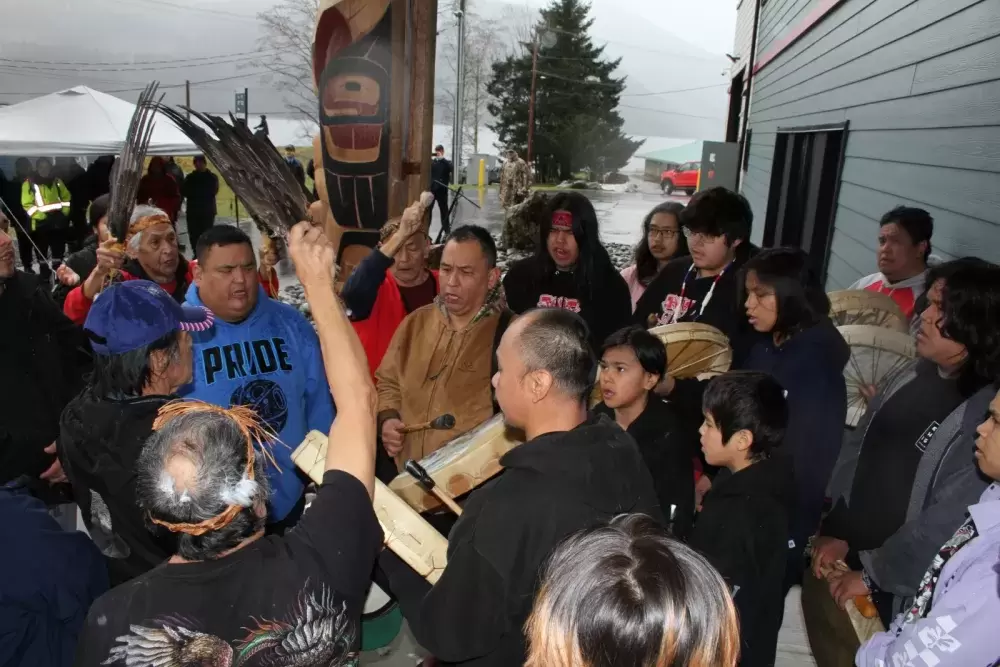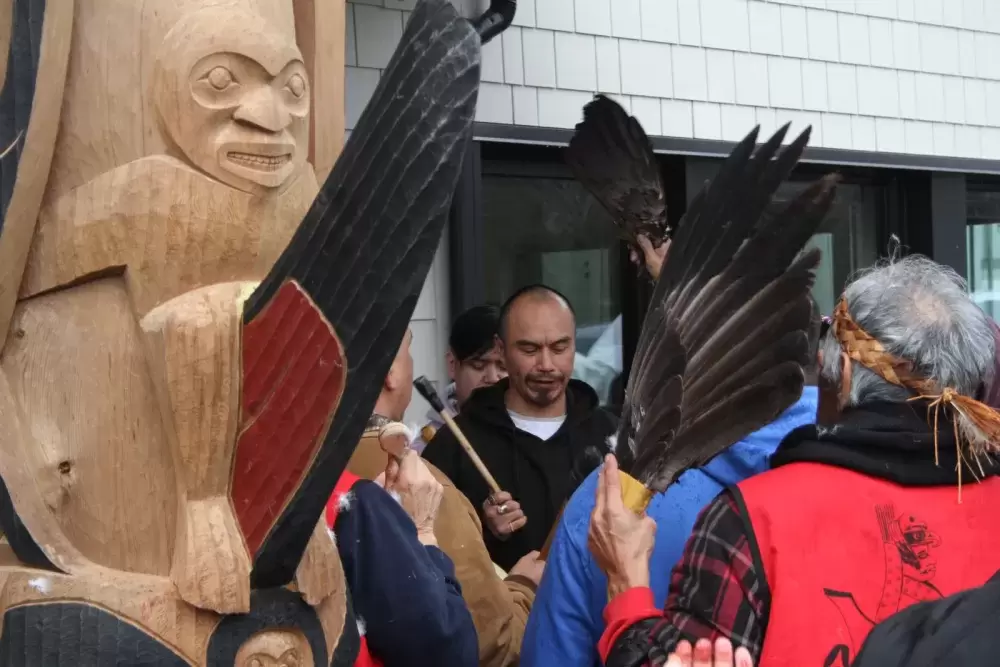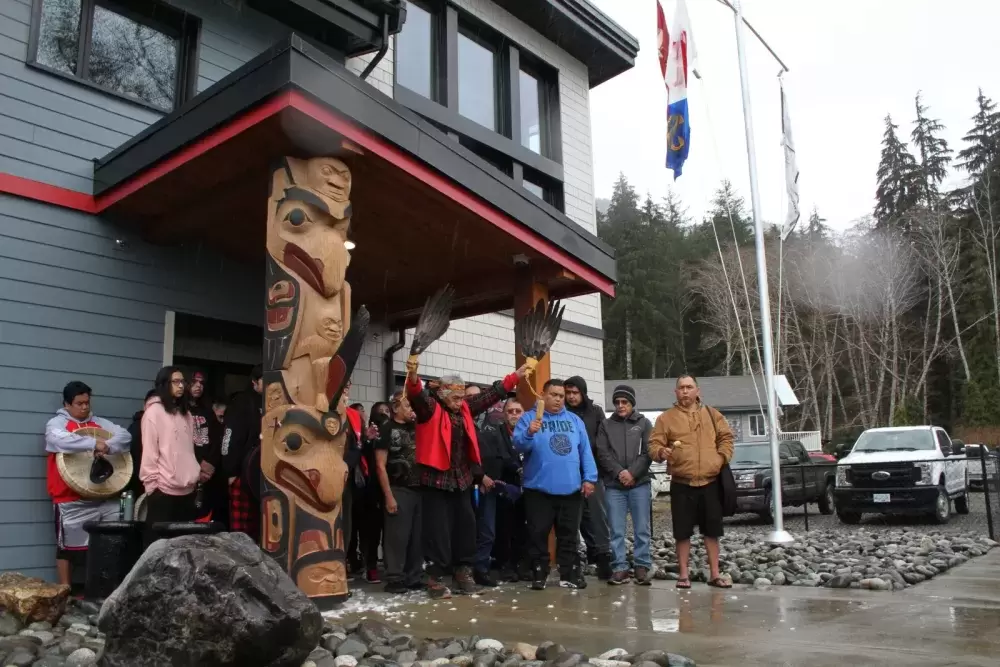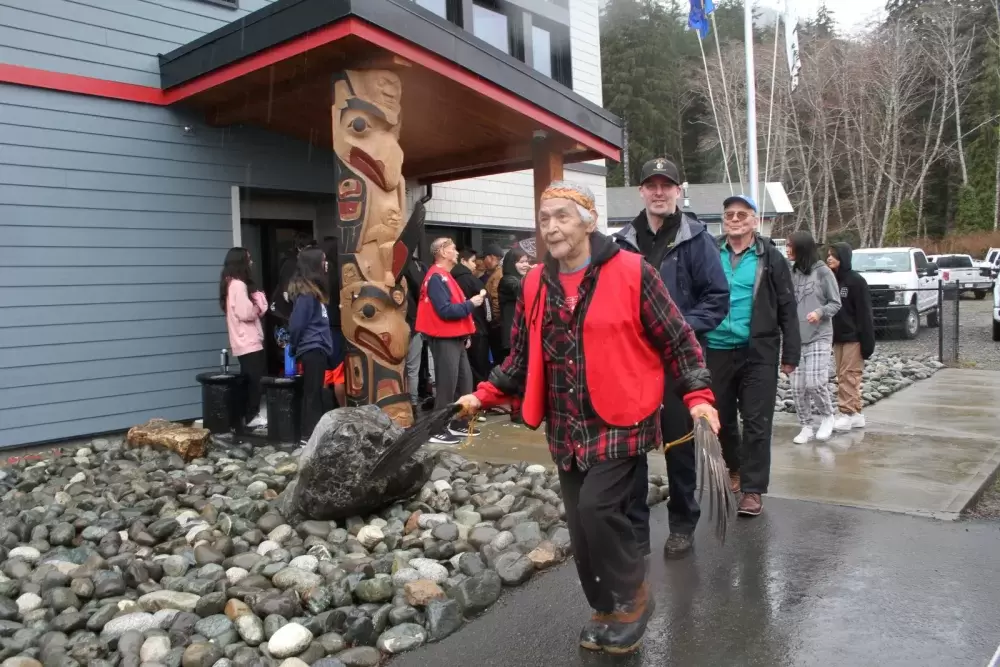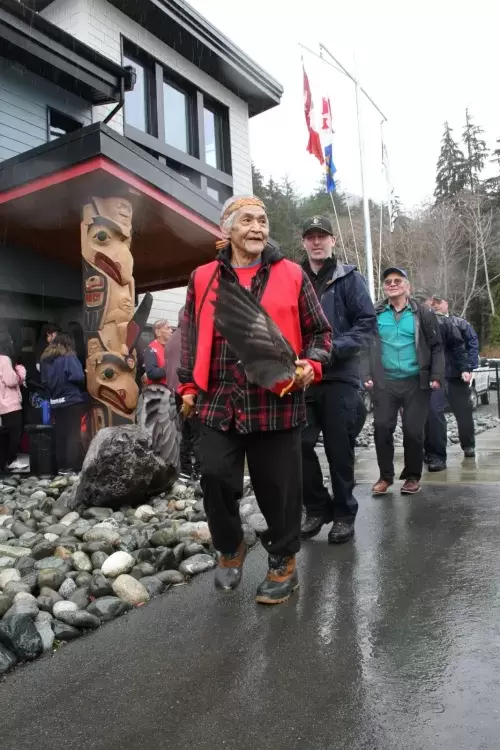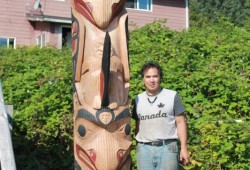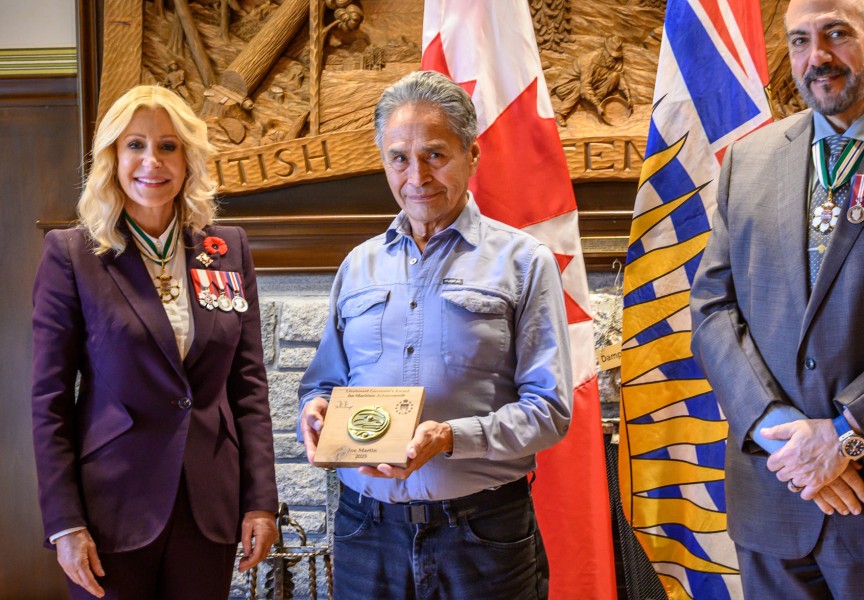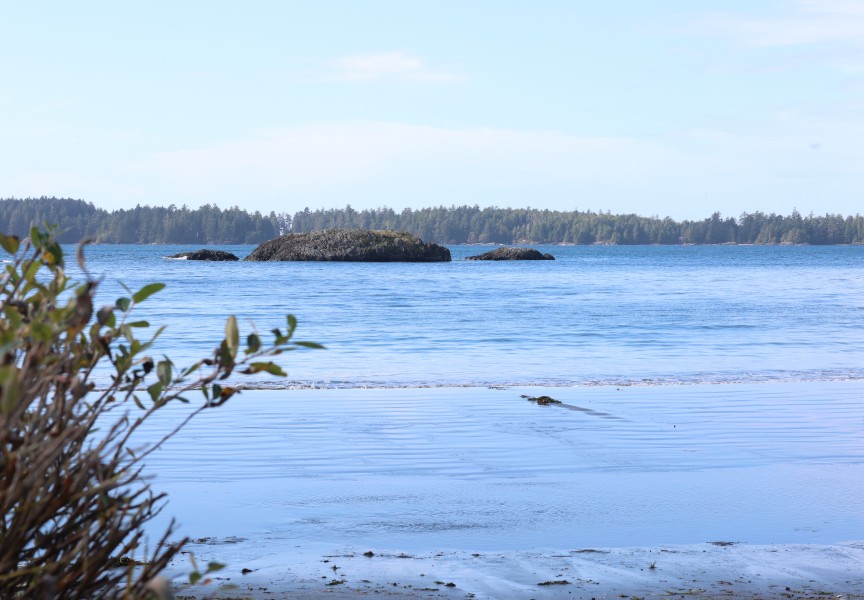On a rainy April morning in the Village of Tahsis, voices from the Mowachaht/Muchalaht First Nation broke through the downpour with traditional song, reminding the crowd that their ancestors occupied the remote coastal site for thousands of years.
On April 6 the Canadian Coast Guard formally recognized this heritage when two artworks were unveiled at its Tahsis station: a totem pole carved by Sanford Williams and a conference room door bearing the carvings and painting of Patrick Amos.
Presentation of the pieces, which were both made by Mowachaht/Muchalaht members, served as another nod to the continued partnership between the First Nation and the coast guard, which is tasked with ensuring safety in the surrounding waters of Nootka Sound.
Completed in 2020, the Tahsis Coast Guard station was among a wave of four facilities that were opened by the federal department to better serve the B.C. coast, with other sites established in Prince Rupert, Port Renfrew and Victoria. At the end of the Tahsis Inlet, the coast guard station works in communication with the Nootka Lighthouse, which has stood at the mouth of the sound since 1911 in the traditional Mowachaht/Muchalaht village of Yuquot.
The coast guard station came to Tahsis after consistent lobbying from the First Nation.
“We realized that the coast guard is a significant service to the region, particularly Mowachaht/Muchalaht,” said Tyee Ha’wilth Mike Maquinna. “We figured that Tahsis is a centralized place for those other areas that they need to serve.”
“They wanted it out in Friendly Cove, but there was not enough resources with transportation and fuel,” said Tom Mark, Mowachaht/Muchalaht’s coast guard liaison, referencing that Yuquot was initially considered for the location.
Now in operation, the Tahsis station presents employment opportunity for the First Nation, as a crew of half a dozen is available at the site at any given time.
“It’s opening doors for young people with training,” added Mark.
In recent years the First Nation’s collaboration with the coast guard became critical in the handling of a shipwreck that for over 50 years has sat 100 metres under the ocean’s surface by Bligh Island in Nootka Sound. In September of 2020 an oily sheen was discovered emerging from the site where the Schiedyk lies, an 8,700-tonne Holland America freighter that hit a reef and sank on Jan. 3, 1968 after leaving from Tahsis the day before.
In close consultation with the Mowachaht/Muchalaht, offshore booms and shoreline cleanup crews were employed to contain the spill. Using the expertise of the US-based Resolve Marine Group, by the summer of 2021 the remaining fuel was removed from the wreck, totalling 60 tonnes of heavy oil and diesel. Another 48,511 kilograms of oil and oily waste was recovered from the surrounding environment.
***
On the rainy April morning eagle down floated through the air like snow around the totem pole after its covering was removed at the station’s entrance, as Mowachaht/Muchalaht elders blessed the piece with a brushing from eagle feathers and the blowing of a whistle. Such protocol is undertaken to solidify the totem’s place as an immovable object, explained elder Tony Dick.
“We have to bless it, wake it up, so nothing goes wrong,” he said. “That totem pole cannot be touched anymore, it cannot be moved, it is stuck there now. If it falls, it stays.”
Titled Guardians of the Land and Sea, the totem project was assigned to Sanford Williams in March of 2019. By that time a red cedar log had already washed up on the beach and been set aside at Yuquot. Williams started working on the log in June at his old waterfront carving shed in Yuquot, and by the end of August the totem project was finished.
“I like to do a lot of my work out there because that’s where I feel the energy out there, the connection with the land,” reflected Williams, who began carving as a youth when he was growing up in the Nootka Island village site. “Because it’s so peaceful I reconnect with my land out there.”
The red cedar log that would become the totem pole was set aside by Sanford’s late father Ray, who lived in Yuquot for the majority of his life. Sanford credits his father for sharing stories that would inspire the creation of the pole’s figures, including the depiction of a wolf transforming into a killer whale. Ray passed in late October at the age of 80.
“I used to like talking with him about stuff like that,” reflected Sanford.
Sanford lives for most of the year in Hope, B.C., and was unable to attend the totem’s unveiling. But his brother Darrell Williams, who lives down the Inlet in Yuquot, was present to speak for the family.
“My dad was so proud of my brother for what he does for a living,” said Darrell before the crowd in Tahsis. “My dad would have been really proud to be here with all our people.”
***
Inside the station another piece presents images deeply tied to Mowachaht/Muchalaht heritage. On the way into the building’s conference room a door carries the work of Patrick Amos, who on one side painted Chief Maquinna wearing a bearskin robe, with a whale harpoon, a float that was used to carry the animals to shore after they were hunted, a thunderbird and a lightning snake.
On the other side of the door a carving depicts First Nations people in a canoe, with two ravens flying overhead. Amos said the idea for the ravens came from a story he heard from a friend about a woman who went missing off Vancouver Island’s west cost about a decade ago. While visiting Ahousaht, the friend and someone else performed a chant, resulting in four ravens circling overhead.
“He got his brother in law to get on the CB radio to tell people that we were looking for the missing lady from Ahousaht,” recalled Amos.
The ravens headed to Catface Mountain, ending at a location where the missing woman was found alive.
“They followed the ravens and they stopped right above where she was at,” said Amos.
The door illustration was carved in red cedar, a material of choice for Amos, who has been making a living as an artist for decades.
“We use cedar for everything,” he said. “In the month of May you can start harvesting cedar bark, you can take a strip out of each tree so that your tree will still live. The inner bark is used for clothing, for capes and dance regalia. And then the wood is used for making canoes, making homes, big houses, totem poles, everything.”
***
For the Mowachaht/Muchalaht people, Tahsis was a seasonal home for this traditional lifestyle for thousands of years. Before the winter storms hit the outer coast, the tribe would relocate their village from Yuquot to the more sheltered site at the end of the Tahsis Inlet.
“This is our winter home, it’s our safety home,” said Dick.
The First Nation’s annual relocation to Tahsis is detailed in the writings of John. R. Jewitt, a British blacksmith who was captured by Chief Maquinna for two years after the Mowachaht overtook the Boston in 1803 while the ship was anchored by Yuquot. Jewitt recounts when “the whole tribe” left Yuquot on Sept. 3, 1803 to travel 30 miles north up the Tahsis Inlet, “the navigation of which is very dangerous from the great number of reefs and rocks with which it abounds.”
“On these occasions everything is taken with them, even the planks of their houses, in order to cover their new dwellings,” continued Jewitt in his observations of the Mowachaht’s migration to Tahsis. “To a European, such a removal exhibits a scene quite novel and strange: canoes piled up with boards and boxes, and filled with men, women and children of all ranks and sizes, making the air resound with their cries and songs.”
From the current coast guard station, Dick points across the inlet to a reserve where his ancestors benefitted from a productive river.
“Right beside the reserve is the river where we used to get all of our fish from,” he said.
Over 200 years ago, Jewitt documented the Mowachaht’s harvesting practices at the site.
“The salmon are taken at Tahsis, principally in pots or weirs,” wrote the British captive. “This pot or weir is placed at the foot of a fall or rapid where the water is not very deep, and the fish, driven from above with long poles, are intercepted and caught in the weir, from whence they are taken into the canoes. In this manner I have seen more than 700 salmon caught in the space of 15 minutes.”
***
Such a bounty enabled the Mowachaht to trade with their Kwakwaka’wakw neighbours directly north. The Kwakiutl regularly used a trading route from what is now Alert Bay, via the Nimpkish River and Woss Lake. Known as “The Grease Trail”, this route ended with an overland passage from the mouth of Woss Lake to Tahsis, a walking trail extending 12 kilometres, according to information published by the Village of Tahsis.
“They used to pack their canoes all the way over this way, the Kwakiutl,” explained Dick. “They used to be able to go over to Yuquot.”
While the Mowachaht could produce large quantities of smoked salmon, their neighbours to the north brought Eulachon oil made from the small fish that are found in rivers within B.C.’s mainland.
“It turns into grease. We call it kleena,” said Dick. “It would be used for everything. It’s a medicine for a lot of our people. It keeps them healthy, it cleans their insides.”
A song has even been shared that developed from the generations of travel along Vancouver Island’s Grease Trail to Tahsis.
“We got permission to sing it from the people of Alert Bay,” said Dick. “It was given to us to use anytime we want to, because we’ve always been close to them, the Kwakiutl people…We have relatives over there.”

